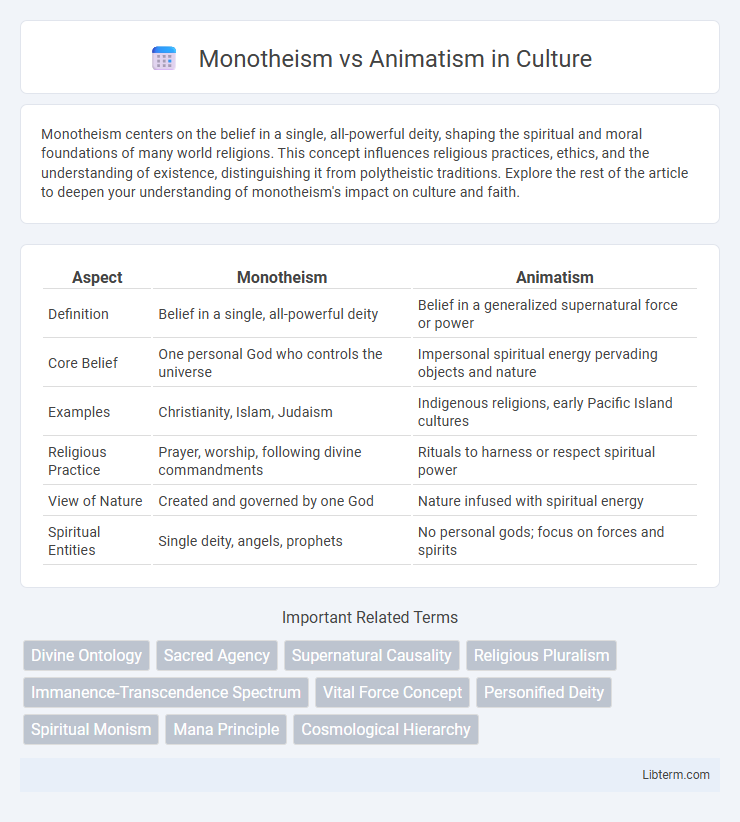Monotheism centers on the belief in a single, all-powerful deity, shaping the spiritual and moral foundations of many world religions. This concept influences religious practices, ethics, and the understanding of existence, distinguishing it from polytheistic traditions. Explore the rest of the article to deepen your understanding of monotheism's impact on culture and faith.
Table of Comparison
| Aspect | Monotheism | Animatism |
|---|---|---|
| Definition | Belief in a single, all-powerful deity | Belief in a generalized supernatural force or power |
| Core Belief | One personal God who controls the universe | Impersonal spiritual energy pervading objects and nature |
| Examples | Christianity, Islam, Judaism | Indigenous religions, early Pacific Island cultures |
| Religious Practice | Prayer, worship, following divine commandments | Rituals to harness or respect spiritual power |
| View of Nature | Created and governed by one God | Nature infused with spiritual energy |
| Spiritual Entities | Single deity, angels, prophets | No personal gods; focus on forces and spirits |
Understanding Monotheism: Core Concepts
Monotheism centers on the belief in a single, all-powerful deity who governs the universe with omniscience and omnipresence, forming the foundation of many world religions such as Christianity, Islam, and Judaism. This concept emphasizes a personal, transcendent God who establishes moral laws and maintains a covenant with humanity. Understanding monotheism involves recognizing its role in shaping ethical frameworks, religious practices, and the human quest for meaning through a singular divine entity.
Defining Animatism: An Overview
Animatism is a belief system that attributes spiritual power or supernatural force to impersonal objects or natural phenomena, distinguishing it from monotheism, which centers on a single, personal deity. This concept emphasizes the pervasive presence of an abstract force rather than worshiping a god or gods, often influencing early religious practices and cultural rituals. Understanding animatism provides insight into the diverse ways human societies interpret and engage with the spiritual world.
Historical Origins of Monotheism
The historical origins of monotheism trace back to ancient civilizations, particularly in the Near East, where early religious systems gradually shifted from polytheistic beliefs to the worship of a single deity. Egyptian Pharaoh Akhenaten is often credited with one of the earliest monotheistic reforms around 1350 BCE, emphasizing Aten, the sun disk, as the sole god, influencing later monotheistic traditions. This transition contrasted with animatism, which attributes spiritual essence to impersonal forces or objects rather than a singular god, reflecting a fundamentally different understanding of supernatural power in human history.
Roots and Development of Animatism
Animatism represents one of the earliest forms of religious belief, characterized by the attribution of an impersonal spiritual force to objects, places, and living beings, contrasting with the personal deity focus in monotheism. Rooted in prehistoric animistic traditions, animatism developed as early humans sought to explain natural phenomena through the presence of a pervasive, neutral energy rather than identifying individual gods. This foundational belief system influenced later religions by establishing the concept of spiritual energy permeating the world, serving as a precursor to more complex religious philosophies.
Key Beliefs of Monotheistic Traditions
Monotheistic traditions center on the belief in a single, all-powerful deity who governs the universe with purpose and moral authority, epitomized by religions such as Christianity, Islam, and Judaism. These faiths emphasize concepts like divine omniscience, omnipotence, and omnibenevolence, along with the idea of a personal relationship between humans and God. In contrast, animatism attributes spiritual essence to natural forces and objects, lacking a centralized god figure and instead focusing on impersonal spiritual power.
Animatism in Traditional and Indigenous Cultures
Animatism in traditional and Indigenous cultures represents a belief system where a generalized, impersonal spiritual force permeates all things, contrasting sharply with the singular god worshipped in monotheism. This spiritual force is often viewed as a vital energy or power that influences natural events and human experiences without embodying a conscious deity. Indigenous practices frequently involve rituals aimed at harnessing or respecting this animating force, underscoring a deep connection between the community, nature, and the cosmos.
Comparing Spiritual Worldviews: One God vs. Spiritual Forces
Monotheism centers on the belief in a single, omnipotent God who governs the universe, embodying a unified spiritual authority and moral order. In contrast, animatism attributes spiritual power to impersonal forces present in objects, places, or beings, emphasizing a distributed, immanent energy rather than a singular deity. This fundamental difference shapes religious expression, rituals, and ethical frameworks within cultures that adopt either a monotheistic or animatistic worldview.
Social and Cultural Impact of Monotheism
Monotheism fundamentally reshaped social structures by promoting centralized religious authority and unifying diverse communities under a single divine law, which strengthened political institutions and social cohesion. It fostered ethical monism, influencing legal codes and moral standards that permeate cultural practices, education, and art across civilizations. The emphasis on one deity also encouraged exclusivity in worship, leading to shifts in religious traditions and intergroup relations, often redefining identity and power dynamics in societies.
Animatism’s Influence on Rituals and Daily Life
Animatism significantly shapes rituals and daily life by emphasizing the presence of impersonal spiritual forces in natural objects and phenomena. Communities practicing animatism engage in ceremonies to harness or appease these forces, influencing hunting, agriculture, and social cohesion. This belief system fosters a deep respect for nature, guiding ethical behavior and the collective well-being of the group.
Modern Perspectives: Coexistence and Contrast
Modern perspectives on monotheism and animatism highlight both coexistence and contrast in contemporary religious thought. Monotheism, characterized by belief in a single, all-powerful deity, often emphasizes centralized doctrines and moral frameworks, while animatism involves the attribution of spiritual force or life energy to objects and natural phenomena, reflecting a more decentralized spiritual approach. Scholars note that despite differing ontologies, these belief systems can coexist within pluralistic societies, fostering diverse expressions of spirituality and cultural identity.
Monotheism Infographic

 libterm.com
libterm.com